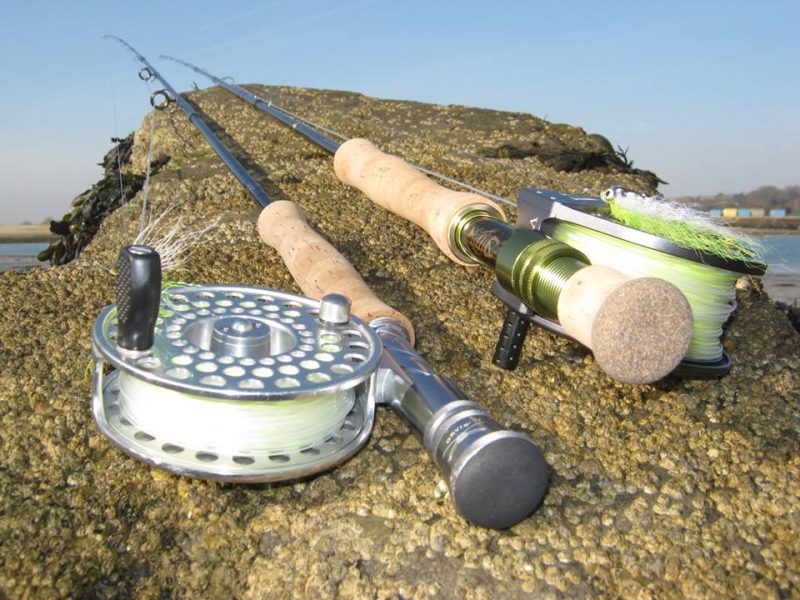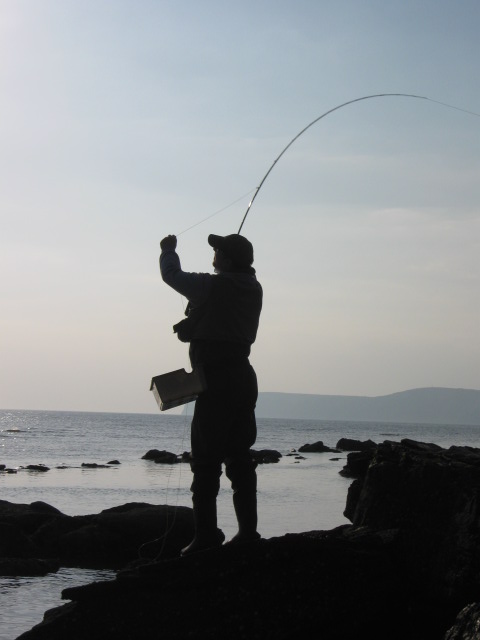https://www.silverscalesflytying.co.uk/wp-content/uploads/2018/03/chriss-pics-364.jpg
In the previous two articles I covered the subjects of whether to tie your own flies and which one's to tie if you decided to have a go yourself. I have made the assumption so far that the reader is already suitably equipped to fish in the salt with regards to rod, reel, line etc. However I am going to back track a bit as I wasn't going to cover equipment in this series of articles but perhaps I should as it will give the novice a better idea of where i'm going when I move onto location and actually fishing your flies in the salt.
There is a plethora of opinion on what rods, reels and lines to use online, and for my two pence worth what I will say on that subject is spend as much as you can possible afford and then push your budget further because when it comes to fly fishing in the salt it does not pay to skimp on your equipment and you will only end up failing due to inadequate gear that makes the whole experience hard work and totally un enjoyable and will hinder the task of catching fish.
The first subject is Rods. Fly rods for Saltwater fly fishing must be robust, they MUST have Anodised fittings that are resistant to the savage corrosion that attacks normal rod fittings. Any metal parts on rings and reel seats will be subject to this if they are not saltwater proofed. I would always recommend washing all your gear down in fresh water after a session regardless but this is not always enough if the fittings on your rod are not salt proof. The higher the modulus of the Carbon the better. Weight wise an 8 or 9 weight rod is what you should be aiming at, preferably 9 feet in length and personally I would always recommend a fast actioned rod for the salt. Medium fast rods are ok and will cover most situations, and will be easier for a novice to learn to cast but modern fly lines suitable for the coast are leaning towards heavier than traditional ratings to cope with throwing a line out in coastal winds and the rod needs to be able to cope with that. As I have already mentioned it really does not pay to buy cheap with Saltwater rods, they simply will not perform adequately due to the lower modulus carbon used, unfortunately it is simply one area that cannot be compromised on.
Reels are another item of equipment that must be Saltwater proof. As already stated the salt air and water will simply eat through any metal that is not anodised. Large arbour reels are ideal, and again try and spend as much as you can afford on this item so that it provides longevity as well as perform adequately. A good drag is useful as well as quality bearings that are shielded from water ingress.
Having Saltwater fly fished for numerous years I have come to realise that Line choice is probably THE most important aspect after Rod choice, in fact they must really be considered together, a mis matched rod and line will only work against you. I mentioned earlier that modern lines designed for coastal work are leaning towards heavier than traditional line ratings, what I mean is an 8 weight line designed for coastal use will actually be heavier than an 8 weight line designed for Trout or general use using the traditional 'grains' rating. The heads on coastal lines are shorter and denser so the weight is more concentrated allowing you to cast larger flies in strong breezes. Hence why I stated that a fast actioned rod is the best way to go, The heavier lines can over load lesser actioned rods causing the rod to run out of power and you end up with the cast collapsing around you. Casting on the coast is nothing like casting at a Trout lake or even for Pike, coastal winds can be cruel and unpredictable and if you haven't the set up to cope it will be a real struggle. I have always recommended Rio lines, but many people seem to find them too expensive and prefer to hunt down cheaper alternatives, but as with many things to buy cheap is to buy twice. You get what you pay for with fly lines as you do rods so don't say I didn't warn you! The Line needs to be extremely durable due to the rigours of salt water, it needs to have that short, compact, dense head of around 30-37 feet with a nice smooth running line to enable maximum distance. Depending on where you intend fishing and the depth of water you expect to find you should consider both a floating and intermediate line and if you're after Pollock in the deep water rocky coastlines of Ireland and Scotland then a sinking line is probably the order of the day! A floating line will cover depths up to 6-7 feet and an intermediate will serve well for up to 12 feet, any deeper and you'll need the full sinking line.
General equipment I use is a good fly vest, I have a Simms one which has served me well for many years and should go on for many more. Fly boxes need to be the water proof type especially if you spend much of your time wading as I do. Rogue waves will always catch you out soaking you and anything you happen to be carrying! Tools should again be as Saltwater proof as possible and I would always advise washing them after a session and even giving them a light coating of oil on any moving joints such as on scissors and forceps to keep them operating smoothly and keep corrosion out. Sun Glasses are essential both for eye protection as well as seeing into the water, more for wading on uneven ground than fish spotting but of course this can come in handy at times. A hat for me is another essential item, keeping the sun and weather off of your head. A good pair of waders will again be a solid investment, Salt water is cruel on waders and seems to make them deteriorate quicker than fresh water, Neoprenes for early season when the water is still relatively cold and breathable Nylon waders for the summer and autumn when the water is very warm or if you are walking long distances to fish. Boot or stocking foot is up to you but I prefer stocking foot because I tend to have long distances to walk to my marks and wading boots are easier on the feet than wellington style boots.
I always carry my mobile phone with me in a waterproof pouch where it is easily accessible in the event of an emergency should I get into any trouble while on the coast I can quickly summon help. It serves for this purpose and for taking picture records of my catches without having to carry a bulky camera.
So there is a brief summary of my equipment recommendations, I have arrived at this after many years experience of fishing in the Salt, I have made mistakes along the way regarding equipment and so have provided a shortcut for the newcomer giving them the best chance of getting somewhere near right to begin with.
Hopefully this will help with the overall picture when I move on to locating and actually fish for Bass etc on the Coast.
Welcome !
I am a passionate Saltwater fly fisherman. I hope you enjoy browsing the blog and please also visit my Webshop where you will find many high quality materials for tying those Saltwater and Predator flies.
Pages
- Home
- Step by Steps EP Baitfish
- Step by Steps, Mylar Sandeel
- Step by step Mega Laser dub Baitfish
- Step by Step Mylar Sea Trout Candy
- Step by Steps Chris's Shrimp
- Step by Steps, Foam Grasshopper
- Step by Step Polar Flash mini Baitfish
- Step by Step Livebait Dubbing Baitfish
- Step by Step Barred Livebait Minnow
Sunday, 18 March 2018
Saltwater fly fishing- equipment recommendations
Subscribe to:
Post Comments (Atom)

No comments:
Post a Comment
Please leave a comment here if you wish to message me. Thanks.